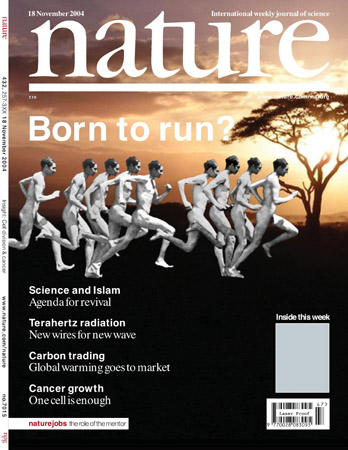
Biology Under Cover
Selected Journal & Book Covers from SBS Faculty
“Endurance running and the evolution of Homo”
Dennis M. Brambleand Daniel E. Liberman
Commentary
This Naturearticle (co-authored with Dan Lieberman of Harvard) makes the case that the evolutionary emergence (approx. 2 million years ago) of the human body was deeply connected to a key shift in behavior that emphasized (uniquely among primates) long-distance running. It documents not only the out-standing running capabilities of modern humans compared to non-human athletes (e.g., horses) but also highlights the anatomical and physiological specializations that underpin this remarkable ability. The study uses insights related to the biomechanics of human running to reevaluate the origin of Homousing direct evidence from the fossil record. Among the most highly referenced in the human evolution literature since its publication, this article helped shift the focus of human locomotor evolution from one that concentrated almost exclusively on bipedal walking to that of running, a behavior that is practiced and enjoyed by countless millions of people around the world. Indirectly, this study provided inspiration for the best-selling book, Born To Run, and through it introduced many ordinary citizens to the science of running and its connection to the story of humankind.
Abstract
Striding bipedalism is a key derived behaviour of hominids that possibly originated soonafter the divergence of the chimpanzee and human lineages. Although bipedal gaits include walking and running, running is generally considered to have played no major role in human evolution because humans, like apes, are poor sprinters compared to most quadrupeds. Here we assess how well humans perform at sustained long-distance running, and review the physiological and anatomical bases of endurance running capabilities in humans and other mammals. Judged by several criteria, humans perform remarkably well at endurance running, thanks to a diverse array of features, many of which leave traces in the skeleton. The fossil evidence of these features suggests that endurance running is a derived capability of the genusHomo, originating about 2 million years ago, and may have been instrumental in the evolution of the human body form.
